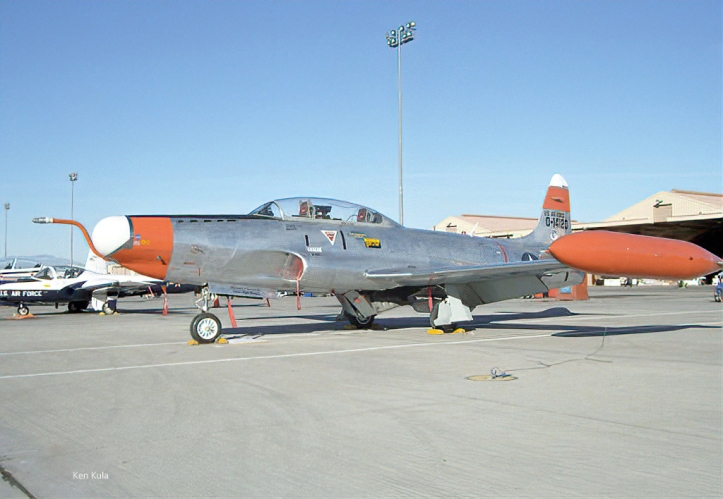
I was born in 1959, making me just shy of 64 years of age as I write this chapter. Looking back to my childhood, I remember the USAF airplanes that flew over my home and those at early air shows in my life. Here are ones that I remember, including what years the models were active trainers.

The Cessna T-37 “Tweet” was introduced in the Air Force in 1957 and retired in 2009. It was the USAF’s primary jet trainer, produced in several versions. It served for over 50 years, and was exported to several countries too.

Lockheed’s T-33A Shooting Star first flew in 1948, and over 6500 airframes were produced in the U.S. and through contracts in other countries. The Air Force’s first jet trainer was used until the T-37 and T-38 tandem entered service during late 1950s. Air National Guard units used the “T-bird” as proficiency trainers well into the 1970s, one story was told that when the final F-15 Eagle is retired, the pilot would be flown home from the Boneyard in a T-33! (It didn’t happen…).

This was the final T-33 in USAF service, a highly modified version with an F-94 nose grafted on. This was displayed at Nellis AFB in 1997 at the Air Force 50th Anniversary celebration. This jet was retired soon thereafter.

Cessna’s T-41 Mescalero was a C-172 Skyhawk trainer version for the Air Force. First used in 1965 as a lead-in for T-37 jets, several more powerful versions were accepted for use at the U. S. Air Force Academy. This is a T-41D, still in service today in Colorado.

The Slingsby T-3A Firefly was an attempt to retire the T-41 Mescalero as the primary lead-in trainer for the Air Force, but it suffered a series of crashes and engine problems; the type was quickly retired. It was in use from 1993 to 1997, and 113 airframes were accepted. After the type was stood down, the entire fleet was scrapped.

The Cirrus T-53A replaced the T-41 and T-3A trainers beginning in 2011. This is a variant of the SR20 trainer, and replaced a score of T-52A s, earlier Cirrus aircraft that were initially leased from the manufacturer. This type is currently in use.

The Northrop T-38A was first introduced in USAF service in 1961 and is still in use today. Modified into the T-38C, it has an upgraded cockpit and an extended service life. As the USAF’s first supersonic trainer, it was a huge step up from the T-33. Slightly less than 1200 airframes were produced.

The AT-38B version was an advanced fighter trainer, with a gunsight and other equipment for weapons training.

The North American/Rockwell T-39 Sabreliner was ordered by the USAF in 1959 as a pilot proficiency trainer, as well as a light transport. Some 143 airframes were produced for the USAF.

The Boeing T-43A was a modified B-737-200 airliner for use as a navigator training platform. It began service in 1974, and the final airframe was retired from service in 2010.

The Raytheon T-1A Jayhawk is the current USAF navigation trainer, a version of the civilian Beechjet/Hawker 400A business jet. It was introduced in 1992.

The Beechcraft T-6A Texan II is the current USAF primary flight trainer. As a replacement for the Cessna T-37, it was introduced into service in 2001. The aircraft’s lineage is from the Swiss Pilatus PC-9 trainer, which was modified for U.S. use by Raytheon.

Convair’s F-106B was a trainer version of the supersonic F-106A Delta Dart interceptor. At Fighter Squadron level, there’d be one or two aircraft assigned to each unit for pilot proficiency and training. The Dart served between 1959 and 1988.

The North American F-100F Super Sabre was produced in a two–seat version which was used for training, beginning in 1958. They were phased out by the USAF in 1979, and the Air National Guard by 1988. This and many other airframes were modified into QF-100F Full Scale Aerial Targets.

Five examples of Lockheed’s U-2 Dragon Lady were transformed into TU-2S variants, for pilot training in the specialized aircraft. These aircraft are still in use at California’s Beale AFB.

Likely the fastest USAF training aircraft was the SR-71B. Several airframes were modified into trainers for pilots about to fly the Mach 3+ jets. These operated from Beale AFB alongside the TU-2S trainers, but the Blackbirds have been retired from USAF use since 1998. This airframe was claimed by NASA for research duties… all SR-71s in NASA use were retired in 1999.
Published by Ken Kula
Join me as I show the results of my chasing airplanes around the world for over thirty-five years. View all posts by Ken Kula